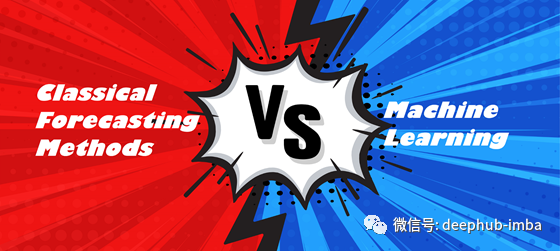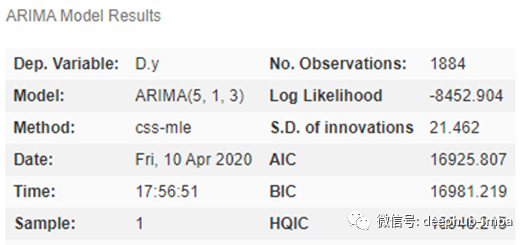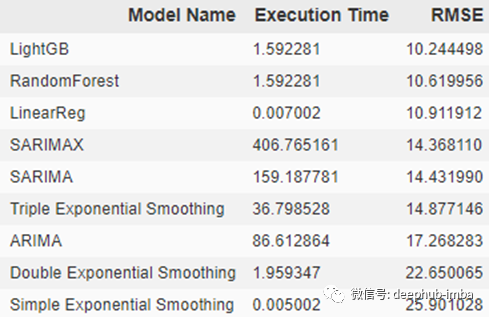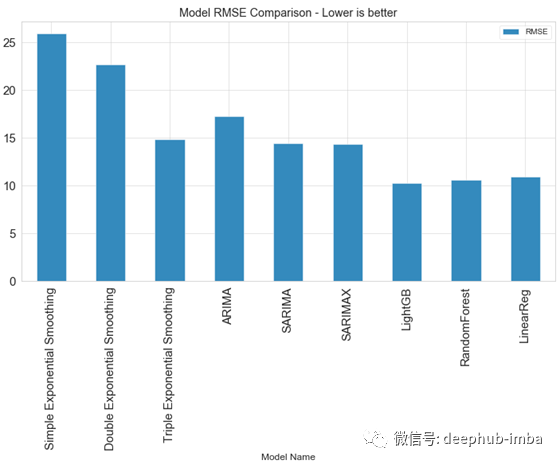
本文使用的数据集来自 kaggle:M5 Forecasting — Accuracy。该数据集包含有 California、Texas、Wisconsin 三个州的产品类别、部门、仓储信息等。基于这些数据,需要预测接下来 28 天的每日销售量。

本文代码 github见最后部分
涉及到的方法有:
- 单指数平滑法
- 双指数平滑法
- 三指数平滑法
- ARIMA
- SARIMA
- SARIMAX
- Light Gradient Boosting
- Random Forest
- Linear Regression
为了使用上述方法,首先导入相应的包/库:
importtime
importwarnings
importnumpyasnp
importpandasaspd
importseabornassns
importlightgbmaslgb
fromitertoolsimportcycle
fromsklearn.svmimportSVR
importstatsmodels.apiassm
frompmdarimaimportauto_arima
importmatplotlib.pyplotasplt
fromdatetimeimportdatetime, timedelta
fromsklearn.metricsimportmean_squared_error
fromsklearn.linear_modelimportLinearRegression
fromsklearn.ensembleimportRandomForestRegressor
fromstatsmodels.graphics.tsaplotsimportplot_acf
fromstatsmodels.tsa.holtwintersimportSimpleExpSmoothing, ExponentialSmoothing
%matplotlibinline
plt.style.use('bmh')
sns.set_style("whitegrid")
plt.rc('xtick', labelsize=15)
plt.rc('ytick', labelsize=15)
warnings.filterwarnings("ignore")
pd.set_option('max_colwidth', 100)
pd.set_option('display.max_rows', 500)
pd.set_option('display.max_columns', 500)
color_pal = plt.rcParams['axes.prop_cycle'].by_key()['color']
color_cycle = cycle(plt.rcParams['axes.prop_cycle'].by_key()['color'])
然后导入数据集:
data = pd.read_csv('data_for_tsa.csv')
data['date'] = pd.to_datetime(data['date'])
data.head()
数据集前五行数据

数据集包含了 2011-01-29 到 2016-05-22 期间的 1941 天的数据。其中最后 28 天作为测试集。
预测目标是
demand
,即:当日的产品销售量。
接下来进行数据集划分
测试集包含了 2016-03-27 到 2016-04-24 期间的 28 天的数据。2016-03-27 之前的其他数据则作为训练数据。
train = data[data['date'] <= '2016-03-27']
test = data[(data['date'] >'2016-03-27') & (data['date'] <= '2016-04-24')]
fig, ax = plt.subplots(figsize=(25,5))
train.plot(x='date',y='demand',label='Train',ax=ax)
test.plot(x='date',y='demand',label='Test',ax=ax);
时间序列数据

为了便于对比所有方法的准确性,建立一个命名为
predictions
的 dataframe,将每个方法设为其中的一行。建立一个命名为
stats
的 dataframe,用于存储每个方法的性能表现和计算时间。
predictions = pd.DataFrame()
predictions['date'] = test['date']
stats = pd.DataFrame(columns=['Model Name','Execution Time','RMSE'])
训练及评价模型
单指数平滑方法
通过调用
SimpleExpSmoothing
包,可以使用 EWMA, Exponentially Weighted Moving Average方法——一种单指数平滑方法。
使用 EWMA 方法,我们首先需要定义
span
变量——数据集的季节周期。
fig, ax = plt.subplots(figsize=(15, 3))
plot_acf(data['demand'].tolist(), lags=60, ax=ax);
自相关图

查看数据的自相关图可知,每隔七个数据,达到一个峰值,也就意味着任一数据与之前的第七个时间数据具有较高的相关性。所以这里将
span
设为 7。
具体地,通过以下代码实现单指数平滑方法预测:
t0 = time.time()
model_name='Simple Exponential Smoothing'
span = 7
alpha = 2/(span+1)
#train
simpleExpSmooth_model = SimpleExpSmoothing(train['demand']).fit(smoothing_level=alpha,optimized=False)
t1 = time.time()-t0
#predict
predictions[model_name] = simpleExpSmooth_model.forecast(28).values
#visualize
fig, ax = plt.subplots(figsize=(25,4))
train[-28:].plot(x='date',y='demand',label='Train',ax=ax)
test.plot(x='date',y='demand',label='Test',ax=ax);
predictions.plot(x='date',y=model_name,label=model_name,ax=ax);
#evaluate
score = np.sqrt(mean_squared_error(predictions[model_name].values, test['demand']))
print('RMSE for {}: {:.4f}'.format(model_name,score))
stats = stats.append({'Model Name':model_name, 'Execution Time':t1, 'RMSE':score},ignore_index=True)
单指数平滑方法预测结果

上述代码实现了对于数据的学习,通过
forcast(x),x=28
,预测了接下来 28 天的数据。并且通过均方根误差衡量误差。
双指数平滑方法
单指数平滑方法只使用了一个平滑系数 ,而双指数平滑方法则引入了第二个平滑系数 ,以反映数据的趋势。使用双指数平滑方法,我们需要定义
seasonal_periods
。
具体代码如下:
t0 = time.time()
model_name='Double Exponential Smoothing'
#train
doubleExpSmooth_model = ExponentialSmoothing(train['demand'],trend='add',seasonal_periods=7).fit()
t1 = time.time()-t0
#predict
predictions[model_name] = doubleExpSmooth_model.forecast(28).values
#visualize
fig, ax = plt.subplots(figsize=(25,4))
train[-28:].plot(x='date',y='demand',label='Train',ax=ax)
test.plot(x='date',y='demand',label='Test',ax=ax);
predictions.plot(x='date',y=model_name,label=model_name,ax=ax);
#evaluate
score = np.sqrt(mean_squared_error(predictions[model_name].values, test['demand']))
print('RMSE for {}: {:.4f}'.format(model_name,score))
stats = stats.append({'Model Name':model_name, 'Execution Time':t1, 'RMSE':score},ignore_index=True)
双指数平滑方法预测结果

三指数平滑方法
三指数平滑方法进一步引入了系数以反映数据的趋势及季节性变化。
具体代码如下:
t0 = time.time()
model_name='Triple Exponential Smoothing'
#train
tripleExpSmooth_model = ExponentialSmoothing(train['demand'],trend='add',seasonal='add',seasonal_periods=7).fit()
t1 = time.time()-t0
#predict
predictions[model_name] = tripleExpSmooth_model.forecast(28).values
#visualize
fig, ax = plt.subplots(figsize=(25,4))
train[-28:].plot(x='date',y='demand',label='Train',ax=ax)
test.plot(x='date',y='demand',label='Test',ax=ax);
predictions.plot(x='date',y=model_name,label=model_name,ax=ax);
#evaluate
score = np.sqrt(mean_squared_error(predictions[model_name].values, test['demand']))
print('RMSE for {}: {:.4f}'.format(model_name,score))
stats = stats.append({'Model Name':model_name, 'Execution Time':t1, 'RMSE':score},ignore_index=True)
三指数平滑方法预测结果

从预测结果可以看出,三指数平滑方法能够学习数据的季节性变化特征。
ARIMA
使用 ARIMA 方法,首先需要确定
p,d,q
三个参数。
p是AR项的顺序。d是使时间序列平稳所需的差分次数q是MA项的顺序。
自动确定 ARIMA 所需参数
通过调用
auto_arima
包,可以自动确定 ARIMA 所需的参数。
t0 = time.time()
model_name='ARIMA'
arima_model = auto_arima(train['demand'], start_p=0, start_q=0,
max_p=14, max_q=3,
seasonal=False,
d=None, trace=True,random_state=2020,
error_action='ignore', # we don't want to know if an order does not work
suppress_warnings=True, # we don't want convergence warnings
stepwise=True)
arima_model.summary()
auto_arima 的计算结果

确定了
p,d,q
参数,就可以进行下一步的训练及预测:
#train
arima_model.fit(train['demand'])
t1 = time.time()-t0
#predict
predictions[model_name] = arima_model.predict(n_periods=28)
#visualize
fig, ax = plt.subplots(figsize=(25,4))
train[-28:].plot(x='date',y='demand',label='Train',ax=ax)
test.plot(x='date',y='demand',label='Test',ax=ax);
predictions.plot(x='date',y=model_name,label=model_name,ax=ax);
#evaluate
score = np.sqrt(mean_squared_error(predictions[model_name].values, test['demand']))
print('RMSE for {}: {:.4f}'.format(model_name,score))
stats = stats.append({'Model Name':model_name, 'Execution Time':t1, 'RMSE':score},ignore_index=True)
ARIMA 预测结果

这里使用的简单ARIMA模型不考虑季节性,是一个(5,1,3)模型。这意味着它使用5个滞后来预测当前值。移动窗口的大小等于 1,即滞后预测误差的数量等于1。使时间序列平稳所需的差分次数为 3。
SARIMA
SARIMA 是 ARIMA 的发展,进一步引入了相关参数以使得模型能够反映数据的季节变化特征。
通过
auto_arima
相关代码,将参数设置为
seasonal=True
,
m=7
,自动计算 SARIMA 所需的参数。
t0 = time.time()
model_name='SARIMA'
sarima_model = auto_arima(train['demand'], start_p=0, start_q=0,
max_p=14, max_q=3,
seasonal=True, m=7,
d=None, trace=True,random_state=2020,
out_of_sample_size=28,
error_action='ignore', # we don't want to know if an order does not work
suppress_warnings=True, # we don't want convergence warnings
stepwise=True)
sarima_model.summary()
auto_arima 计算结果

确定了参数后,接下来进行训练及预测:
#train
sarima_model.fit(train['demand'])
t1 = time.time()-t0
#predict
predictions[model_name] = sarima_model.predict(n_periods=28)
#visualize
fig, ax = plt.subplots(figsize=(25,4))
train[-28:].plot(x='date',y='demand',label='Train',ax=ax)
test.plot(x='date',y='demand',label='Test',ax=ax);
predictions.plot(x='date',y=model_name,label=model_name,ax=ax);
#evaluate
score = np.sqrt(mean_squared_error(predictions[model_name].values, test['demand']))
print('RMSE for {}: {:.4f}'.format(model_name,score))
stats = stats.append({'Model Name':model_name, 'Execution Time':t1, 'RMSE':score},ignore_index=True)
SARIMA 预测结果

SARIMAX
使用前面的方法,我们只能基于前面的历史数据进行预测。在 SARIMAX 中引入外生回归因子(eXogenous regressors),可以实现对时间序列数据以外的数据的分析。
本例中,我们引入
sell_price
数据以辅助更好地预测。
t0 = time.time()
model_name='SARIMAX'
sarimax_model = auto_arima(train['demand'], start_p=0, start_q=0,
max_p=14, max_q=3,
seasonal=True, m=7,
exogenous = train[['sell_price']].values,
d=None, trace=True,random_state=2020,
out_of_sample_size=28,
error_action='ignore', # we don't want to know if an order does not work
suppress_warnings=True, # we don't want convergence warnings
stepwise=True)
sarimax_model.summary()
auto_arima 计算结果

通过 auto_arima 自动计算了 SARIMAX 方法所需的参数后,可以直接进行训练和预测。
#train
sarimax_model.fit(train['demand'])
t1 = time.time()-t0
#predict
predictions[model_name] = sarimax_model.predict(n_periods=28)
#visualize
fig, ax = plt.subplots(figsize=(25,4))
train[-28:].plot(x='date',y='demand',label='Train',ax=ax)
test.plot(x='date',y='demand',label='Test',ax=ax);
predictions.plot(x='date',y=model_name,label=model_name,ax=ax);
#evaluate
score = np.sqrt(mean_squared_error(predictions[model_name].values, test['demand']))
print('RMSE for {}: {:.4f}'.format(model_name,score))
stats = stats.append({'Model Name':model_name, 'Execution Time':t1, 'RMSE':score},ignore_index=True)
SARIMA 预测结果

从预测结果可以看出,通过分析额外的数据,有助于减少误差。
机器学习
使用机器学习方法,首先需要特征数据以及指标数据。
在本文中,基于时间序列数据构造特征数据如下:
- 特征数据1:滞后数据。选择 7 天前的
demand数据作为特征数据。 - 特征数据2:移动平均数据。选择 7 天前至 14 天之前的
demand移动平均值数据作为特征数据。 - 特征数据3:月销售均值
- 特征数据4:每月销售最大值
- 特征数据5:每月销售最小值
- 特征数据6:每月销售最大值与最小值的差值
- 特征数据7:每周销售均值
- 特征数据8:每周销售最大值
- 特征数据9:每周销售中值
具体代码如下:
deflags_windows(df):
lags = [7]
lag_cols = ["lag_{}".format(lag) forlaginlags ]
forlag, lag_colinzip(lags, lag_cols):
df[lag_col] = df[["id","demand"]].groupby("id")["demand"].shift(lag)
wins = [7]
forwininwins :
forlag,lag_colinzip(lags, lag_cols):
df["rmean_{}_{}".format(lag,win)] = df[["id", lag_col]].groupby("id")[lag_col].transform(lambdax : x.rolling(win).mean())
returndf
defper_timeframe_stats(df, col):
#For each item compute its mean and other descriptive statistics for each month and dayofweek in the dataset
months = df['month'].unique().tolist()
foryinmonths:
df.loc[df['month'] == y, col+'_month_mean'] = df.loc[df['month'] == y].groupby(['id'])[col].transform(lambdax: x.mean()).astype("float32")
df.loc[df['month'] == y, col+'_month_max'] = df.loc[df['month'] == y].groupby(['id'])[col].transform(lambdax: x.max()).astype("float32")
df.loc[df['month'] == y, col+'_month_min'] = df.loc[df['month'] == y].groupby(['id'])[col].transform(lambdax: x.min()).astype("float32")
df[col+'month_max_to_min_diff'] = (df[col+'_month_max'] -df[col+'_month_min']).astype("float32")
dayofweek = df['dayofweek'].unique().tolist()
foryindayofweek:
df.loc[df['dayofweek'] == y, col+'_dayofweek_mean'] = df.loc[df['dayofweek'] == y].groupby(['id'])[col].transform(lambdax: x.mean()).astype("float32")
df.loc[df['dayofweek'] == y, col+'_dayofweek_median'] = df.loc[df['dayofweek'] == y].groupby(['id'])[col].transform(lambdax: x.median()).astype("float32")
df.loc[df['dayofweek'] == y, col+'_dayofweek_max'] = df.loc[df['dayofweek'] == y].groupby(['id'])[col].transform(lambdax: x.max()).astype("float32")
returndf
deffeat_eng(df):
df = lags_windows(df)
df = per_timeframe_stats(df,'demand')
returndf
准备数据:
data = pd.read_csv('data_for_tsa.csv')
data['date'] = pd.to_datetime(data['date'])
train = data[data['date'] <= '2016-03-27']
test = data[(data['date'] >'2016-03-11') & (data['date'] <= '2016-04-24')]
data_ml = feat_eng(train)
data_ml = data_ml.dropna()
useless_cols = ['id','item_id','dept_id','cat_id','store_id','state_id','demand','date','demand_month_min']
linreg_train_cols = ['sell_price','year','month','dayofweek','lag_7','rmean_7_7'] #use different columns for linear regression
lgb_train_cols = data_ml.columns[~data_ml.columns.isin(useless_cols)]
X_train = data_ml[lgb_train_cols].copy()
y_train = data_ml["demand"]
模型拟合
通过 light gradient boosting、linear regression、random forest 三种方法对数据进行拟合:
#Fit Light Gradient Boosting
t0 = time.time()
lgb_params = {
"objective" : "poisson",
"metric" :"rmse",
"force_row_wise" : True,
"learning_rate" : 0.075,
"sub_row" : 0.75,
"bagging_freq" : 1,
"lambda_l2" : 0.1,
'verbosity': 1,
'num_iterations' : 2000,
'num_leaves': 128,
"min_data_in_leaf": 50,
}
np.random.seed(777)
fake_valid_inds = np.random.choice(X_train.index.values, 365, replace = False)
train_inds = np.setdiff1d(X_train.index.values, fake_valid_inds)
train_data = lgb.Dataset(X_train.loc[train_inds] , label = y_train.loc[train_inds], free_raw_data=False)
fake_valid_data = lgb.Dataset(X_train.loc[fake_valid_inds], label = y_train.loc[fake_valid_inds],free_raw_data=False)
m_lgb = lgb.train(lgb_params, train_data, valid_sets = [fake_valid_data], verbose_eval=0)
t_lgb = time.time()-t0
#Fit Linear Regression
t0 = time.time()
m_linreg = LinearRegression().fit(X_train[linreg_train_cols].loc[train_inds], y_train.loc[train_inds])
t_linreg = time.time()-t0
#Fit Random Forest
t0 = time.time()
m_rf = RandomForestRegressor(n_estimators=100,max_depth=5, random_state=26, n_jobs=-1).fit(X_train.loc[train_inds], y_train.loc[train_inds])
t_rf = time.time()-t0
模型预测
值得注意的是,在训练阶段,我们使用了7 天前的 demand 数据以及 7 天前至 14 天之前的 demand 移动平均值数据作为特征数据。但是在预测阶段,是没有 demand 数据的。因此这里需要借助滑动窗口,sliding window,的概念,也就是每次计算一个预测数据。为了计算移动平均值数据,设置滑动窗口长度为 15。
通过滑动窗口方法预测未知数据的具体代码如下:
fday = datetime(2016,3, 28)
max_lags = 15
fortdeltainrange(0, 28):
day = fday+timedelta(days=tdelta)
tst = test[(test.date>= day-timedelta(days=max_lags)) & (test.date<= day)].copy()
tst = feat_eng(tst)
tst_lgb = tst.loc[tst.date == day , lgb_train_cols].copy()
test.loc[test.date == day, "preds_LightGB"] = m_lgb.predict(tst_lgb)
tst_rf = tst.loc[tst.date == day , lgb_train_cols].copy()
tst_rf = tst_rf.fillna(0)
test.loc[test.date == day, "preds_RandomForest"] = m_rf.predict(tst_rf)
tst_linreg = tst.loc[tst.date == day , linreg_train_cols].copy()
tst_linreg = tst_linreg.fillna(0)
test.loc[test.date == day, "preds_LinearReg"] = m_linreg.predict(tst_linreg)
test_final = test.loc[test.date>= fday]
Light Gradient Boosting
model_name='LightGB'
predictions[model_name] = test_final["preds_"+model_name]
#visualize
fig, ax = plt.subplots(figsize=(25,4))
train[-28:].plot(x='date',y='demand',label='Train',ax=ax)
test_final.plot(x='date',y='demand',label='Test',ax=ax);
predictions.plot(x='date',y=model_name,label=model_name,ax=ax);
#evaluate
score = np.sqrt(mean_squared_error(predictions[model_name].values, test_final['demand']))
print('RMSE for {}: {:.4f}'.format(model_name,score))
stats = stats.append({'Model Name':model_name, 'Execution Time':t_lgb, 'RMSE':score},ignore_index=True)
Light Gradient Boosting 预测结果

Random Forest
model_name='RandomForest'
predictions[model_name] = test_final["preds_"+model_name]
#visualize
fig, ax = plt.subplots(figsize=(25,4))
train[-28:].plot(x='date',y='demand',label='Train',ax=ax)
test_final.plot(x='date',y='demand',label='Test',ax=ax);
predictions.plot(x='date',y=model_name,label=model_name,ax=ax);
#evaluate
score = np.sqrt(mean_squared_error(predictions[model_name].values, test_final['demand']))
print('RMSE for {}: {:.4f}'.format(model_name,score))
stats = stats.append({'Model Name':model_name, 'Execution Time':t_lgb, 'RMSE':score},ignore_index=True)
Random Forest 预测结果

Linear Regression
model_name='LinearReg'
predictions[model_name] = test_final["preds_"+model_name]
#visualize
fig, ax = plt.subplots(figsize=(25,4))
train[-28:].plot(x='date',y='demand',label='Train',ax=ax)
test_final.plot(x='date',y='demand',label='Test',ax=ax);
predictions.plot(x='date',y=model_name,label=model_name,ax=ax);
#evaluate
score = np.sqrt(mean_squared_error(predictions[model_name].values, test_final['demand']))
print('RMSE for {}: {:.4f}'.format(model_name,score))
stats = stats.append({'Model Name':model_name, 'Execution Time':t_linreg, 'RMSE':score},ignore_index=True)
Linear Regression 预测结果

以上就是所有的预测方法及过程。各个方法的运算时间及结果误差如下:
stats.sort_values(by='RMSE')
stats.plot(kind='bar',x='Model Name', y='RMSE', figsize=(12,6), title="Model RMSE Comparison - Lower is better");
各个方法的运算时间及结果误差对比

各个方法的结果误差对比

可以看出,传统预测方法的性能相较于机器学习预测方法较差。
但是这个结论并不是绝对的。方法的准确度取决于不同的问题背景。机器学习方法依赖于特征数据。如果我们只有时间序列数据,那么特征数据较为缺乏,我们可以基于原始数据创建特征数据,如滞后数据、移动平均数据等。因此机器学习方法要呈现更好地预测结果,特征工程至关重要。在机器学习领域,某种程度上,数据才是起决定作用,而不是模型或者算法。
作者:Dimitris Effrosynidis
deephub翻译组: Oliver Lee
DeepHub
微信号 : deephub-imba
每日大数据和人工智能的重磅干货
大厂职位内推信息
长按识别二维码关注 ->
好看就点在看!********** **********